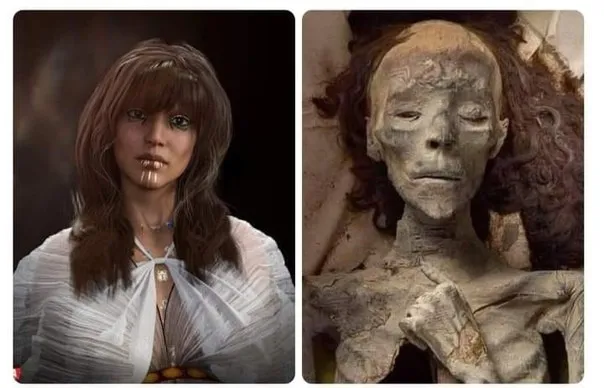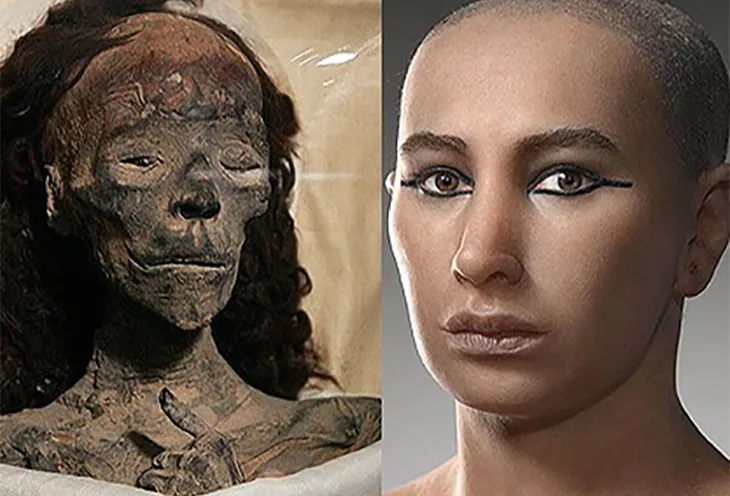Chilling Resurrection: The Terrifying Face of Queen Tiye from 1338 BC Unearthed from Her Mummy in Cairo
Unveiling the Past: The Reconstruction of Queen Tiye’s Face
In a remarkable fusion of archaeology and technology, the face of Queen Tiye, one of ancient Egypt’s most influential figures, has been reconstructed based on her mummy, which resides in the National Museum of Egyptian Civilization in Cairo. Queen Tiye, who lived around 1338 BC, was the mother of Pharaoh Akhenaten and the grandmother of the famed Tutankhamun. This groundbreaking reconstruction offers an extraordinary glimpse into the appearance of a woman who played a pivotal role in the history of ancient Egypt.

The Historical Significance of Queen Tiye
Queen Tiye was a central figure during the 18th Dynasty of Egypt, a period marked by significant political and religious changes. As the wife of Pharaoh Amenhotep III and the mother of Akhenaten, Tiye was deeply involved in the affairs of state. Her influence extended to her grandchildren, including Tutankhamun, whose reign is often highlighted by the discovery of his richly adorned tomb.
Tiye was renowned not only for her political acumen but also for her prominence in religious reforms and diplomatic relations. Her role in these spheres underscores the importance of understanding her physical appearance and personal attributes, as they offer insights into the cultural and political dynamics of her time.
The Reconstruction Process
The process of reconstructing Queen Tiye’s face was a meticulous endeavor that combined advanced forensic science with artistic interpretation. The reconstruction was based on a well-preserved mummy found in the National Museum of Egyptian Civilization. This mummy, which has been studied extensively, provided the crucial data needed for the reconstruction.
- CT Scanning and Imaging: The first step involved using CT scans to create detailed three-dimensional images of the mummy’s skull. These scans revealed essential information about the structure of Tiye’s face, including the shape of her bones and the characteristics of her features.
- Forensic Analysis: Forensic experts analyzed the data to determine Tiye’s likely facial features, such as the shape of her nose, lips, and eyes. This analysis considered the anatomical structure of the skull as well as common traits among other mummies from the same period.
- Artistic Reconstruction: With the scientific data in hand, skilled artists then used the information to reconstruct Tiye’s face. This artistic phase involved creating a lifelike model based on the forensic data, aiming to capture her appearance as accurately as possible.
- Cultural and Historical Context: Throughout the reconstruction, experts took into account the cultural and historical context of Tiye’s time. This ensured that the final image not only reflected her physical appearance but also resonated with the aesthetic and stylistic norms of the 18th Dynasty.
The Impact of the Reconstruction
The reconstructed face of Queen Tiye provides a powerful connection to the past, allowing us to visualize one of ancient Egypt’s most significant figures in a way that historical artifacts alone cannot. It offers a tangible link to the person behind the historical and cultural achievements, bridging the gap between ancient history and modern understanding.
The reconstruction has garnered significant attention from both scholars and the public. It highlights the advancements in forensic technology and its application in archaeology, showcasing how modern methods can illuminate the lives of historical figures.
Legacy and Reflection
The face of Queen Tiye, as reconstructed from her mummy, serves as a poignant reminder of the enduring legacy of ancient Egyptian civilization. It provides an intimate glimpse into the life of a woman who played a crucial role in shaping the course of Egyptian history. As researchers continue to study and learn from such reconstructions, we gain a deeper appreciation for the complexity and richness of the past, bringing to life the stories of those who lived thousands of years ago.







